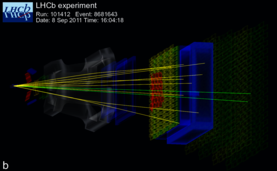Topics: High Energy Physics, Large Hadron Collider, LHC, Particle Physics, Standard Model, Theoretical Physics
Right or wrong, the cultural reference to the blog title here.
At the smallest scales, everything in the universe can be broken down into fundamental morsels called particles. The Standard Model of particle physics—the reigning theory of these morsels—describes a small collection of known species that combine in myriad ways to build the matter around us and carry the forces of nature. Yet physicists know that these particles cannot be all there is—they do not account for the dark matter or dark energy that seem to contribute much of the universe’s mass, for example. Now two experiments have observed particles misbehaving in ways not predicted by any known laws of physics, potentially suggesting the existence of some new type of particle beyond the standard zoo. The results are not fully confirmed yet, but the fact that two experiments colliding different types of particles have seen a similar effect, and that hints of this behavior also showed up in 2012 at a third particle collider, has many physicists animated. “It’s really bizarre,” says Mark Wise, a theorist at the California Institute of Technology who was not involved in the experiments. “The discrepancy is large and it seems like it’s on very sound footing. It’s probably the strongest, most enduring deviation we’ve seen from the Standard Model.” Finding such a crack in the Standard Model is exciting because it suggests a potential path toward expanding the model beyond those particles currently known.
The eyebrow-raising results come from the LHCb experiment at the Large Hadron Collider (LHC) in Switzerland and the Belle experiment at the High Energy Accelerator Research Organization (KEK) in Japan. Both observed an excess of certain types of leptons compared to others produced when particles called B mesons (made of a bottom quark and an antiquark) decay. Leptons are a category of particles that includes electrons, as well as their heavier cousins muons and taus. A Standard Model principle known as lepton universality says that all leptons should be treated equally by the weak interaction, the fundamental force responsible for radioactive decay. But when the experiments observed a large number of B meson decays, which should have produced equal numbers of electrons, muons and taus among their final products (after the different masses of the particles are taken into account), the decays actually made more taus.
Scientific American:
2 Accelerators Find Particles That May Break Known Laws of Physics
Clara Moskowitz

Comments